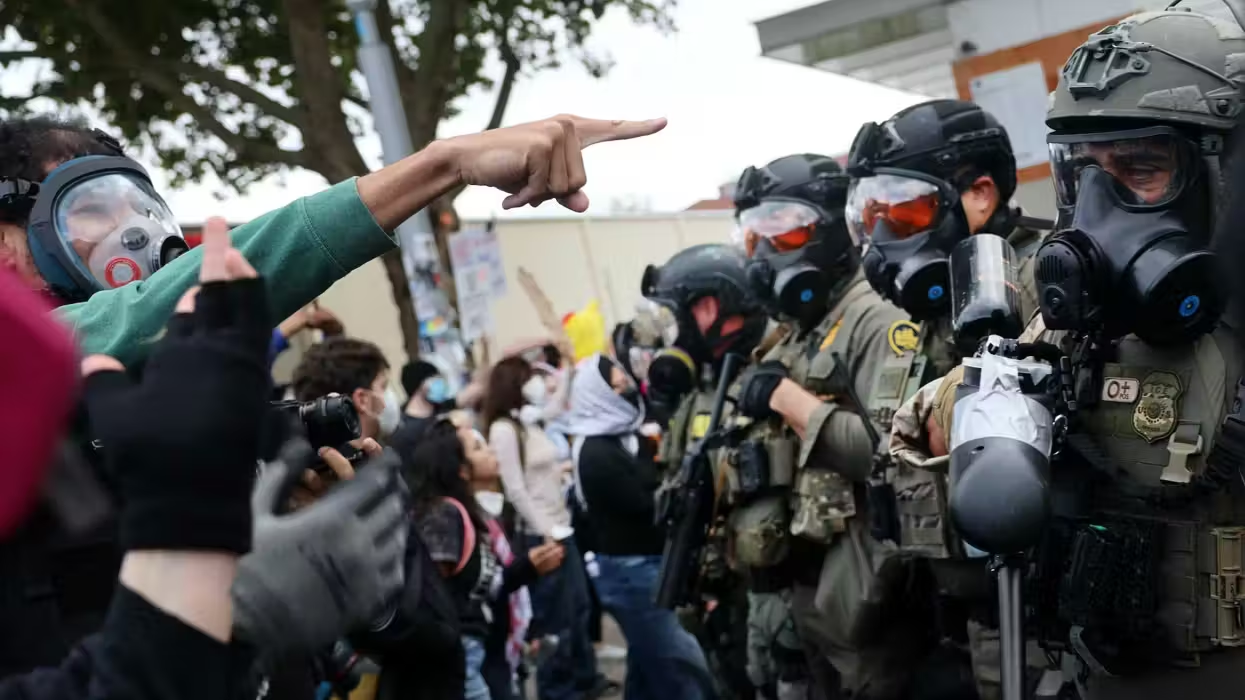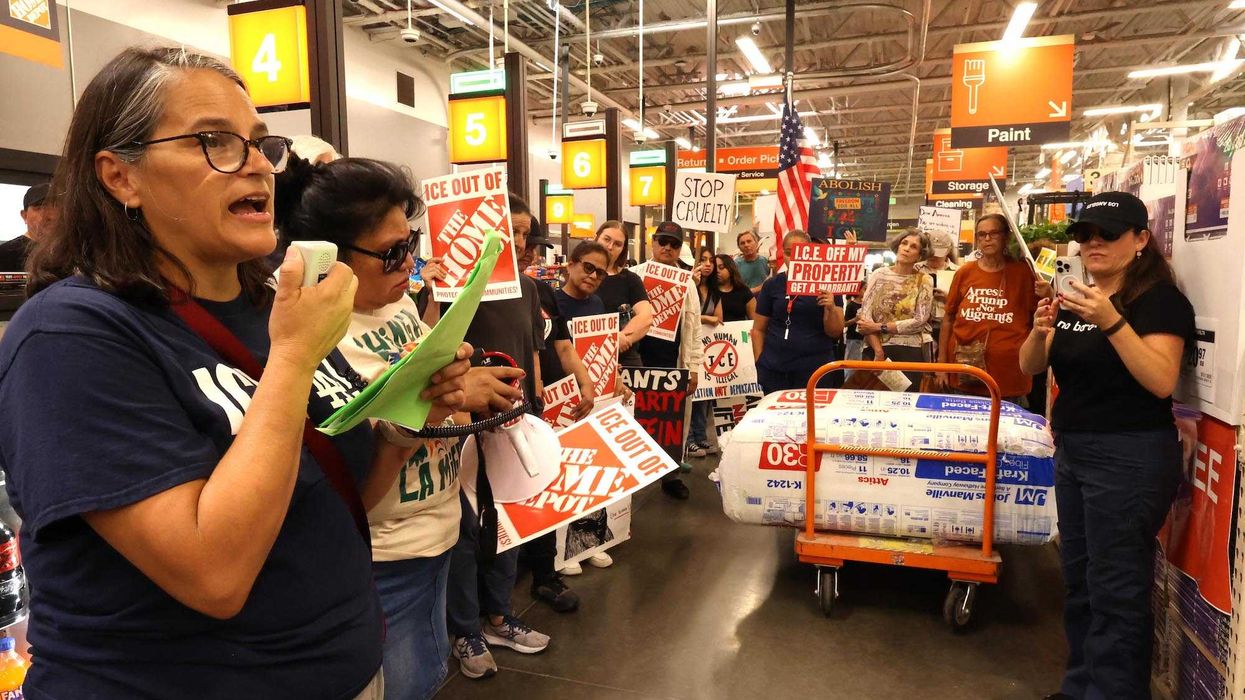Law enforcement organizations are defending a Defense Department program that provides surplus military equipment to local police, even as it faces a White House review and bipartisan criticism after the unrest in Ferguson, Missouri.
Police in the St. Louis suburb were sharply criticized for wearing military gear and using military-style weapons and vehicles to deal with unrest after a white police officer fatally shot 18-year-old Michael Brown, who was black.
 In this April 1, 2014 photo, police use a military-grade vehicle during a standoff in St. Cloud, Minn. (AP Photo/The St. Cloud Times, Jason Wachter)
In this April 1, 2014 photo, police use a military-grade vehicle during a standoff in St. Cloud, Minn. (AP Photo/The St. Cloud Times, Jason Wachter)
While there is the potential for a local police department to misuse its advanced equipment, “that's not a reason to throw the baby out with the bathwater,” Cedric Alexander, president of the National Organization of Black Law Enforcement Executives, told TheBlaze.
“Most Americans watching each night in Ferguson seeing police carrying heavy military rifles pointed at unarmed protestors were concerned, as were politicians and law enforcement,” said Alexander, who also serves as public safety director for DeKalb Country, Georgia. “But there is a place for that type of armament and equipment. When children are held hostage in schools or malls and the bad guys have high-powered rifles and pose a threat to the community, that is the time to use them.”
The White House has announced that the Office of Management and Budget will be reviewing the Defense Department program, known as the 1033 program, to see if the surplus program is necessary to help local law enforcement.
Alexander pointed out that much of the surplus equipment consists of shields, helmets and other gear that does not pose a threat to civilians but protects officers.
“Anytime military equipment is passed down, there should be a process to justify it, and there should be policy and procedures at the departments as to when it is used,” Alexander said.
Other police organizations also believe the surplus program is helpful, arguing law enforcement must change because threats change.
“I have no problem with supplying these law enforcement agencies with military equipment they might need to handle an emergency," said Jack L. Rinchich, president of the National Association of Chiefs of Police. "I think it's totally unfair to expect police officers not to have the equipment they need to do their jobs."
Rinchich, the former police chief for the University of Charleston, said local departments should use the military equipment judiciously.
“The question is not whether police departments should have it, the question is when is it necessary to deploy it,” he said. “If it's not to be used immediately, it should be readily available if a situation grows violent. There is a proper balance between safety and freedom. The key point of the issue is proper deployment and utilization.”
Proper use is largely what the OMB review will involve, White House press secretary Josh Earnest said.
“The question is [whether] the program operating as was intended,” Earnest said last week. “Are there situations in which local law enforcement organizations are getting equipment that they don’t actually need? Are they using government funds to acquire equipment and use it in a way that’s consistent with the way that equipment was intended to be used? Are the individuals at these local law enforcement organizations who are responsible for operating the equipment getting the necessary training to operate that equipment correctly and safely?”
Sen. Rand Paul (R-Ky.) last week criticized the Pentagon program in an op-ed for Time magazine titled, “We Must Demilitarize the Police,” blaming the federal government for encouraging arming up by local law enforcement.
“Not surprisingly, big government has been at the heart of the problem,” Paul wrote. “Washington has incentivized the militarization of local police precincts by using federal dollars to help municipal governments build what are essentially small armies—where police departments compete to acquire military gear that goes far beyond what most of Americans think of as law enforcement.”
Reps. Emanuel Cleaver and Lacy Clay, both Missouri Democrats, met with Defense Secretary Chuck Hagel to express frustration that the program could infringe on constitutional rights.
“That includes the right to assemble and peacefully protest, without the unacceptable threat of an overbearing police response that targets law-abiding citizens with military weapons and technology,” Cleaver said in a statement. “If there is any good that can come out of the tragedy in Ferguson, Missouri, our hope is that this effort will spur a national discussion about how to achieve a fundamental shift in local law enforcement, away from military-style responses, and towards a more community-based policy.”
The 1033 Program, named for section 1033 of the 1997 National Defense Authorization Act, stems from a concept first introduced in the 1990 defense spending bill when pistol-carrying police were forced to contend with machine-gun wielding drug criminals. Many cash-strapped local police and sheriff's offices couldn't afford equipment, so applied to the Defense Department for military rifles, armored vehicles, night vision goggles and body armor.
“They need to be equipped to deal with modern-day risks,” Rinchich of the National Association of Chiefs of Police said. “On the border, officers have to deal with drug cartels that are armed to a T.”
Under the program, the Defense Logistics Agency has allocated about $5 billion worth of surplus military equipment to about 8,000 agencies across the country, according to PolitiFact.
The program gained popularity among local police after the 9/11 attacks, when police, fire departments and EMS lacked sophisticated radios to communicate with first responders in neighboring communities. Earnest said improving communications is a "laudable goal."
Rinchich said the United States need to be prepared for another terror attack with prepared first responders.
“Before the military arrived to respond to a terrorist attack, police would be the first responders,” Rinchich said. “You don't close the back door after the horse is out. We are reactive, which is natural. But we need to be proactive. We need to be concerned if we don't have what we need."
–
Follow Fred Lucas (@FredVLucas3) on Twitter

 In this April 1, 2014 photo, police use a military-grade vehicle during a standoff in St. Cloud, Minn. (AP Photo/The St. Cloud Times, Jason Wachter)
In this April 1, 2014 photo, police use a military-grade vehicle during a standoff in St. Cloud, Minn. (AP Photo/The St. Cloud Times, Jason Wachter)





